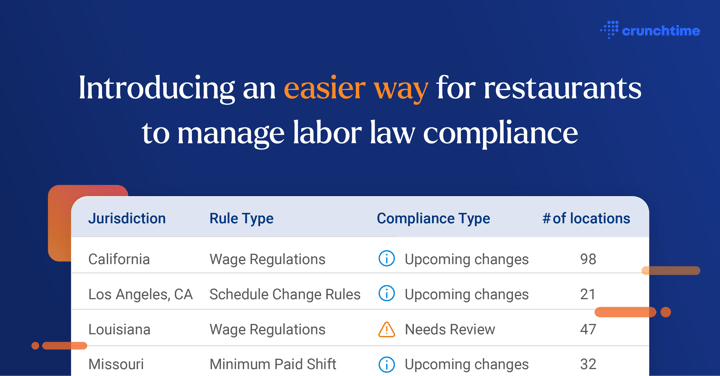
- Home
- Crunchtime Blog
- The Compliance Dilemma: Tackling Labor Laws in the Restaurant Industry

The Compliance Dilemma: Tackling Labor Laws in the Restaurant Industry
In this blog, we'll explore the challenges of compliance and shed light on different strategies restaurants can use to achieve compliance.
Labor Laws Are Complex
From fluctuating schedules to continuously changing regulations, restaurant operators face a myriad of challenges when it comes to compliance. Labor laws are growing increasingly complex, with a labyrinth of regulations at the federal, state, and local levels. Whether it's break requirements or Fair Workweek regulations, understanding and adhering to these laws can require a deep understanding of legal nuances and intricacies that operators are not prepared for.
For many restaurant owners and managers who are already juggling multiple responsibilities, maintaining compliance can be a daunting task But as a restaurant operation grows and scales, compliance becomes harder to ignore. Opening stores in new jurisdictions presents even more complexity, as growth brings more employees, more laws and regulations, and ultimately, more risk. 
Requirements Vary Across Jurisdictions
Labor laws can vary significantly from one jurisdiction to another. Schedules that are compliant in one state or city may not meet the requirements in another. This means that restaurants with multiple locations must navigate a patchwork of regulations, often leading to confusion and inconsistencies in compliance efforts. This variability adds another layer of challenge for restaurant operators who are striving to grow profitably.
Fair Workweek in the United States

Limited Resources and Expertise
One major setback to compliance is that many restaurant operations lack the resources, tools, and expertise needed to effectively manage labor law compliance. Manual scheduling processes, outdated technology systems, limited access to legal resources, and inexperienced management, can all hinder compliance efforts.
The dynamic nature of the restaurant industry also presents a significant hurdle for compliance efforts. With high turnover rates, seasonal fluctuations and unpredictable demand patterns, scheduling staff while complying with all labor laws is no easy feat. Without the proper support and tools in place, restaurants can inadvertently introduce the risk of non-compliance.
Blurred Lines of Legal Liability
The partnership between franchisors and franchisees is a cornerstone of the restaurant industry, but laws like the 2023 Joint Employer Rule have introduced new legal challenges for this dynamic duo. The ruling potentially creates more shared legal risk between franchisees and franchisors in regards to labor laws. The legislation also raises serious questions about the extent to which franchisors should involve themselves in the labor practices of their franchisees.
For many restaurant operators, this increased liability is far from ideal. Sean Kennedy, executive vice president for Public Affairs at the National Restaurant Association, expressed deep concern that the ruling could have adverse effects on entrepreneurship and economic growth, particularly for franchisees in the sector. "The Joint Employer Rule threatens the foundation upon which nearly a third of the restaurant industry is built," said Kennedy.
The 2023 Joint Employer Rule has faced stark opposition and ongoing challenges by different groups. After being delayed, the ruling was recently blocked by a federal court in Texas. President Joe Biden then vetoed the measure to overturn the ruling in May 2024. With the Joint Employer Rule in legal limbo, it’s no surprise that this legal exposure has created confusion and questions for many restaurants operating under the franchise model.
How Can Restaurants Navigate the Compliance Challenge?
Here are several steps that restaurants can take to avoid non-compliance.
- Invest in Technology
One of the most proactive ways a restaurant can achieve compliance is by investing in a technology solution that automates compliance. Using software that automates scheduling, tracks employee hours, and provides compliance guardrails can significantly reduce the risk of non-compliance, while also easing administrative burdens and minimizing errors for your restaurant.
Even if the manager forgets, a compliant scheduling software will remember meal breaks, overtime, predictive scheduling requirements and more. Similarly, using a time clock system can accurately track employee hours worked, monitor clock-in and clock-out times, and generate compliance reports to help you quickly identify and track any violations. Given the complexity of labor laws today, why leave it up to chance?
- Stay Informed
Information is power in the face of the compliance dilemma. Restaurant operators can experience significant disruption when new laws create changes to minimum wage rates, overtime thresholds, or scheduling regulations. These changes can have far-reaching implications for labor costs, staffing levels, and operational workflows, which is why all operators should closely monitor changes to labor laws at the federal, state, and local levels. Staying informed requires close monitoring of legislative updates, regulatory changes, and any judicial rulings that may impact labor practices and policies. Armed with information, restaurants can be more prepared to adjust their policies and practices accordingly, ultimately reducing the risk of non-compliance. - Provide Training
Offering comprehensive training and education on labor laws, compliance requirements, and scheduling tools is a non-negotiable for operators today. These trainings should be designed to equip your managers and staff with the knowledge they need to navigate the intricacies of labor laws like minimum wage, overtime, rest breaks and other scheduling requirements. Educating your teams can help you build a stronger culture of compliance, identify potential compliance risks faster, and address issues proactively. But training on labor laws and compliance requirements is not limited to managers; it is critical for every level of the organization, including hourly employees and multi-unit leaders. Everyone plays a role in achieving compliance, but the initiative must start at the top, with senior leadership and executives setting the tone and priorities for the organization. - Seek Guidance
Never underestimate the value of partnering with legal experts or industry associations for guidance and support on labor law compliance and regulatory matters. Laws like the Joint Employer Status can be open to different legal interpretations, which makes navigating compliance even more difficult. Seeking legal guidance is a proactive measure that will enhance a restaurant operations' readiness and resilience in today's regulatory environment. For the modern day multi-unit restaurant, proactively engaging legal guidance is a strategic move to ensure operational continuity and long-term viability of the business.
Restaurant operators should understand that the compliance dilemma is multifaceted and cannot be solved with one simple solution. Given the complexities of labor laws, varied requirements across jurisdictions, workforce dynamics, and limited resources—a holistic approach to compliance is necessary.
By leveraging technology solutions, staying informed, providing training, and seeking guidance, restaurants can navigate the compliance maze more effectively and ensure they are prepared for growth.
Click here to learn more about achieving labor law compliance for your restaurant operation.
Share this post
Related


Labor Laws Made Easy for Restaurants: Introducing Compliance Reporting


